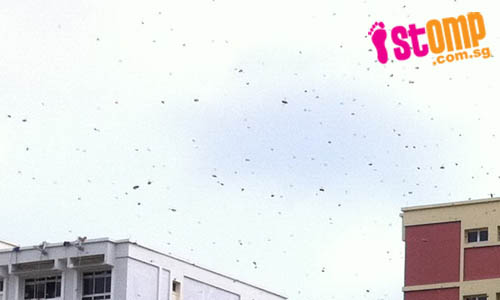
Look closely -- the black specks in these pictures are actually large bees, which have established a hive in this school in the Pasir Ris area.
STOMPer kom wrote:
"This case of bee infestation was spotted months ago in this school, but nothing has been done.
"The school doesn't seem to consider the safety of the students as there might be a bee attack anytime.
"The bee hive has been at the top of the teaching block since January.
"The school is in Pasir Ris."

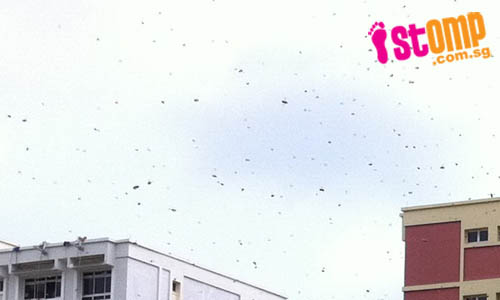
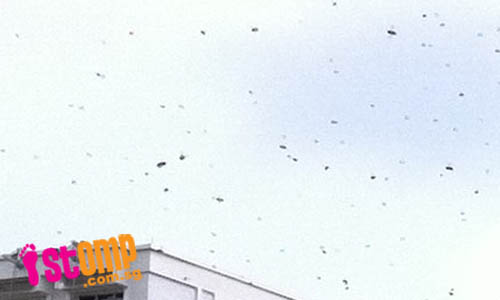



Related posts: Strange bee-haviour: Thousands gather at altar for no reason (17th June 2011)
Beehive spotted on tree outside Suntec City (9th June 2011)
Mild paranoia aside, I would concede that this poses somewhat of a safety concern to students, staff, and residents living in the neighbourhood.
Based on the apparent size of the bees, I would say that these are giant honeybees (Apis dorsata), the largest species of honeybee in Singapore, with workers that can grow up to 20 millimetres long. This species was the focus of a post that I wrote in 2009.

(Photo by kampang)
Giant honeybees are supposedly highly aggressive, reputedly even more so than hornets, and will fiercely defend their colony. This species builds its nest high up on tree branches, or on cliff overhangs and the walls of buildings.
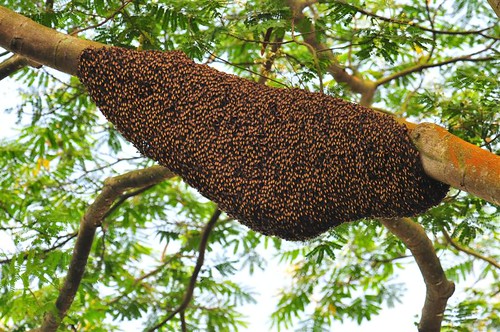
Hive of giant honeybee, Bukit Timah;
(Photo by NatureInYourBackyard)

Giant honeybee nests on cliff, Sarawak;
(Photo by Wakx)
Despite the inaccessibility of its nests, and its aggressive nature, the honey made by this species is highly prized, and people all over its range in tropical Asia go to great risks to gather the honey.

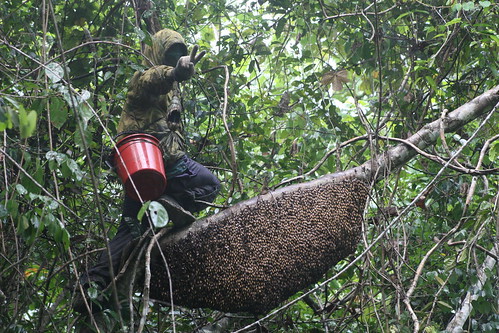
Honey hunting in Terengganu;
(Photos by s'Ruthle)
The giant honeybee has not been domesticated for honey production due to its nomadic nature; unlike other honeybees, these bees don't remain in a single location for long, moving their colonies to follow wherever the flowers are blooming and the nectar is at its most abundant. These migrating swarms have been recorded travelling nearly 100 kilometres before settling down again.

I just picked up this book about honeybees and honey from the library; The Honey Trail: In Pursuit of Liquid Gold and Vanishing Bees looks at honey production in many parts of the world, and how the industry differs from place to place.
Where does honey come from? Everyone knows the answer is 'bees', but where were the bees when they made their honey? In reading this marvelous combination of travel narrative, environmental wakeup call, and food pornography we learn that China is the easiest fallback answer to the question of where any generic honey has come from. We also learn of the connection between Yemeni honey and terrorism, of how Australian feather-bush honey can heal wounds but has nothing on New Zealand's manuka honey, which is so antibacterial it can even cure MRSA (methicillin-resistant Staphylococcus aureus) infections. In Borneo, author Pundyk is questing for the honey of the giant honey bee, Apis dorsata, which is nomadic and whose honey is also used as medicine, and Russia proves to be as enigmatic as it is famous for anyone trying to get information about honey production. Honey is big business in the United Kingdom despite the fact that they produce little honey, but in Italy people want varietal honeys like they want varietal wines. In Turkey the beekeepers are hobbyists, while in the U.S. bees are shipped hundreds of miles by semis to pollinate crops. Pundyk finally visits China, the largest honey producer in the world, accused of 'dumping' honey onto the world market. Full of dauntless travel to backwater areas where no one speaks English, distressing views of the plundering of wilderness areas, and rapturous descriptions of the flavor of local honeys, Pundyk's book helps us understand the global importance of this liquid gold. --Nancy BentLooks like it's an interesting read that examines apiculture in its myriad forms, the problems and challenges faced by beekeepers the world over, as well as our long relationship with honey itself. There's a chapter where the author travels to Borneo and follows the locals who gather honey from giant honeybees in the rainforests of Kalimantan.